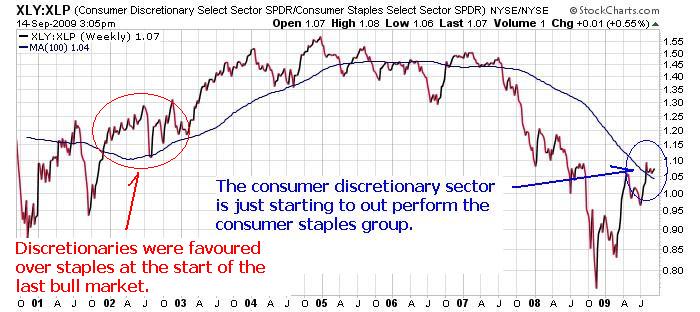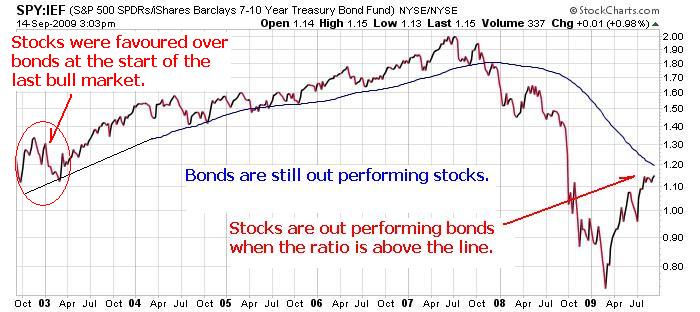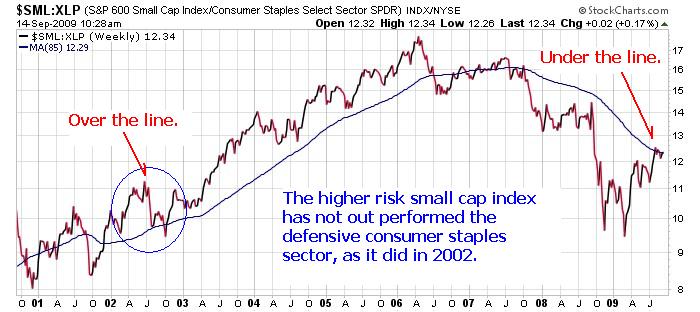Small Cracks in the New Stocks Bull Market
Stock-Markets / Stocks Bull Market Sep 15, 2009 - 12:50 PM GMTBy: Donald_W_Dony
 Fledgling bull markets are normally characterized by a series of internal gauges. Long-term shifts in capital spending between specific industry groups and asset classes have general occurred at the start of every new advance. For example, consumers become less defensive and start purchasing those items that they want but don't really need. Traders move out of safe fixed income assets and look for higher returns in stocks. All of these elements were present at the bottom of the last great bear market and the beginning of the next bull in 2002-2003. But they are still missing in this market.
Fledgling bull markets are normally characterized by a series of internal gauges. Long-term shifts in capital spending between specific industry groups and asset classes have general occurred at the start of every new advance. For example, consumers become less defensive and start purchasing those items that they want but don't really need. Traders move out of safe fixed income assets and look for higher returns in stocks. All of these elements were present at the bottom of the last great bear market and the beginning of the next bull in 2002-2003. But they are still missing in this market.
The single biggest driving force in an economy is the consumer. Their spending habits shape the outlook of the stock market and the business cycle. Consumers typically pull back on their discretionary spending at the top of a frothy market and balance the risk with more defensive purchases through consumer staples. This transfer from one sector class to another, is a leading indicator to the stock market at the top. The opposite also develops at the bottom. In 2002, consumers were starting to ramp-up their spending from safe non cyclicals to items of want (discretionaries). This normal adjustment in spending habits powered up the Consumer Discretionary Sector (XLY) over the Consumer Staples Sector (XLP) six to 12 months before the emerging bull market took root (Chart 1). This lead time before the final trough in the equities markets is typical. That shift in spending is only now beginning to materialize.

New bull markets are generally initiated with capital flowing out of the safety of bonds and searching for higher returns in stocks. Again, this is a standard movement at the bottom of bear markets. Chart 2 illustrates that the S&P 500 ETF (SPY) had greater relative performance over the 7-10-year Treasury Bond Fund (IEF) in 2002 but lacks some of the same strength in 2009. Though the SPY has advanced upward sharply against the fixed income IEF since March, the stock-based ETF (SPY) still remains under the level which signals a clear change from bonds to stocks has occurred.

Another look at the growth-to-safety measure within the markets is the ratio between the S&P 600 Small Cap Index ($SML) and the Consumer Staples Sector (XLP). This gauge reviews the risk attitude of investors within the asset class of equities. For stock markets to advance over a longer-term duration, more capital and buying momentum is needed in the growth oriented small cap sector than in the safety of consumer staples (Chart 3).

During the final year of the severe 2000-2002 bear market, capital began to move over to the S&P 600 Small cap Index even though the bottom did not develop until late in 2002. The growth based small cap sector began to out perform the defensive consumer staples group 12 months before the end of the last bear market. This shift in investor thinking is fairly common as traders are always trying to anticipate the economy 6-8 months forward. In analyzing the current relationship between growth and safety, investors are not showing a long-term preference toward risk and growth. The ratio has only been rising since March and has yet to significantly signal a stronger trend.
Bottom line: Though models are indicating a high probability that the March low was the final bottom in the bear market, internal measurements of buying patterns with consumers and investors are not signally a commitment to longer-term growth. These smaller cracks in the new bull market may resolve themselves over the next six months, but for now, are a signal for caution.
More research can be found in the September newsletter. Go to www.technicalspeculator.com and click on member login.
Your comments are always welcomed.
By Donald W. Dony, FCSI, MFTA
www.technicalspeculator.com
COPYRIGHT © 2009 Donald W. Dony
Donald W. Dony, FCSI, MFTA has been in the investment profession for over 20 years, first as a stock broker in the mid 1980's and then as the principal of D. W. Dony and Associates Inc., a financial consulting firm to present. He is the editor and publisher of the Technical Speculator, a monthly international investment newsletter, which specializes in major world equity markets, currencies, bonds and interest rates as well as the precious metals markets.
Donald is also an instructor for the Canadian Securities Institute (CSI). He is often called upon to design technical analysis training programs and to provide teaching to industry professionals on technical analysis at many of Canada's leading brokerage firms. He is a respected specialist in the area of intermarket and cycle analysis and a frequent speaker at investment conferences.
Mr. Dony is a member of the Canadian Society of Technical Analysts (CSTA) and the International Federation of Technical Analysts (IFTA).
Donald W. Dony Archive |
© 2005-2022 http://www.MarketOracle.co.uk - The Market Oracle is a FREE Daily Financial Markets Analysis & Forecasting online publication.



